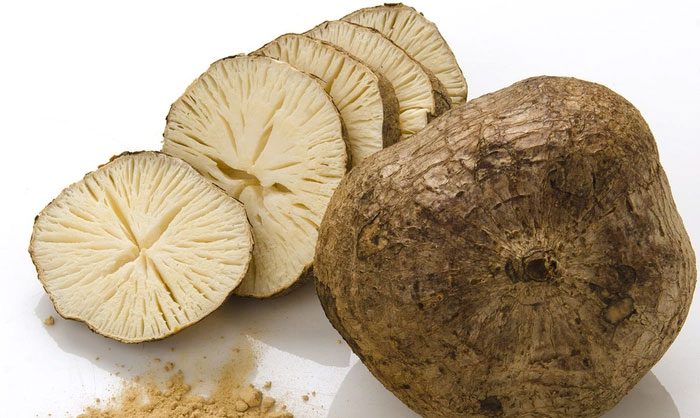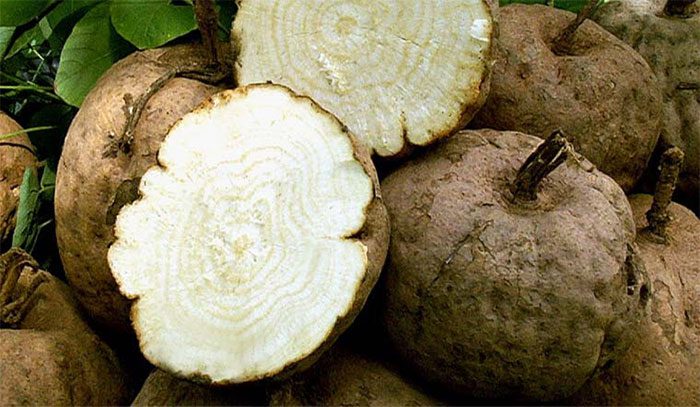This root has been used as a precious medicine by several countries around the world, especially in remedies aimed at “rejuvenation” for over 800 years.
Dr. Huỳnh Tấn Vũ, from Ho Chi Minh City University of Medicine and Pharmacy, states that round cassava root is one of the beneficial foods for women. This root is also known as “Pueraria mirifica” (a beneficial food for women).
Pueraria mirifica has the scientific name Pueraria mirifica Airy Shaw et Suvat. It is a member of the legume family, a sturdy climbing vine that wraps around large tree roots, with palmate leaves, having three leaflets on one petiole. The leaves are simple, oval-shaped, and pointed at the tip. The flowers are pale greenish-purple, with flower clusters up to 30 cm long, growing at the ends of branches. The mature fruit has a brown shell and contains 3-5 seeds. The tubers come in various sizes, resembling sweet potatoes, with white flesh that may cause headaches or dizziness when consumed. The size of the tuber depends on environmental conditions, soil quality, and the duration of cultivation.

Pueraria mirifica is a member of the legume family, a sturdy climbing vine…
Eight hundred years ago, Pueraria mirifica was first discovered in Northern Thailand and Myanmar. Today, this plant is mainly distributed in deciduous forests in Northeast and Northwest Thailand, Myanmar, and India.
In Vietnam, Pueraria mirifica is found in the Northwestern provinces such as Sơn La, Yên Bái, Tuyên Quang, and some mountainous districts in Thanh Hóa and Nghệ An.
Dr. Vũ mentions that Pueraria mirifica is widely used in Thailand as a secret remedy for rejuvenation, with effects that enhance skin beauty, darken hair, improve blood circulation, boost memory, and maintain women’s reproductive health.
In Vietnam, the White Thai ethnic group (in Sơn La) applies Pueraria mirifica root as a facial mask and brews it for drinking to promote long, soft hair, smooth skin, slim waists, and enhance fertility.
“In traditional medicine, Pueraria mirifica has a sweet and spicy taste, a neutral nature, and affects the spleen and stomach meridians. It helps relieve muscle tension, reduce heat, generate body fluids, quench thirst, alleviate cough, uplift energy, and control diarrhea. The flowers of Pueraria mirifica have a sweet taste, a neutral nature, and detoxify alcohol.
According to folk experience, Pueraria mirifica is usually taken at a dose of 5 mg/kg of body weight per day in the evening to combat wrinkles, darken hair, stimulate hair growth, reduce cataracts, support memory treatment, enhance physical strength, improve endurance, increase blood circulation, and treat sleep disorders,” Dr. Vũ added.
Modern medical research indicates that Pueraria mirifica contains approximately 17 compounds that act similarly to female hormones (estrogens), including the following components: phytoestrogens and deoxymiroestrol.

The deoxymiroestrol compound found in Pueraria mirifica mimics estrogen in females.
In 2005, researchers from the University of Reading in the UK conducted studies and discovered that the deoxymiroestrol compound found in Pueraria mirifica has effects similar to female estrogen. This compound is 1,000 to 10,000 times more potent than the two compounds daidzein and genistein extracted from soybeans. Furthermore, Pueraria mirifica helps maintain stable levels of hormones that stimulate the ovaries to produce estrogen (FSH/LH).
Dr. Vũ emphasizes that Pueraria mirifica is also used to alleviate symptoms related to aging and estrogen deficiency such as sagging breasts, wrinkled skin, osteoporosis, and graying hair due to its estrogen-like components.
However, it is important to note that excessive use of Pueraria mirifica can lead to side effects such as dizziness, headaches, and chest pain. Therefore, this herb should be used according to the dosage and duration prescribed by a doctor. Individuals with ovarian cysts or thyroid tumors should consult a physician before using it.




















































